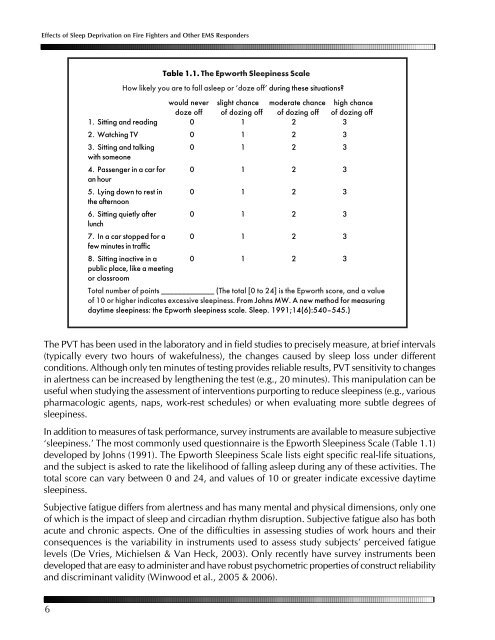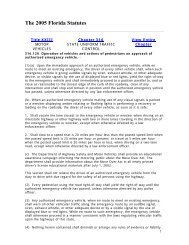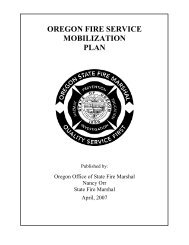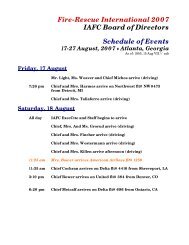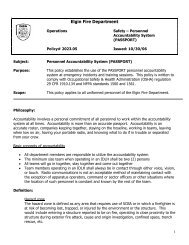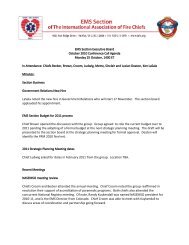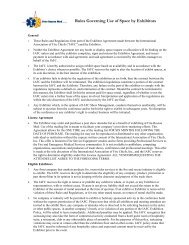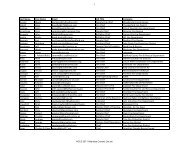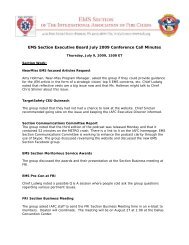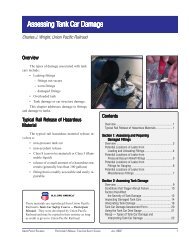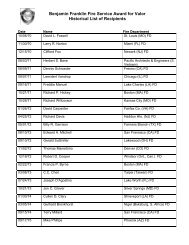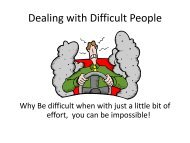Effects of Sleep Deprivation on Fire Fighters and EMS ... - NAEMT
Effects of Sleep Deprivation on Fire Fighters and EMS ... - NAEMT
Effects of Sleep Deprivation on Fire Fighters and EMS ... - NAEMT
Create successful ePaper yourself
Turn your PDF publications into a flip-book with our unique Google optimized e-Paper software.
<str<strong>on</strong>g>Effects</str<strong>on</strong>g> <str<strong>on</strong>g>of</str<strong>on</strong>g> <str<strong>on</strong>g>Sleep</str<strong>on</strong>g> <str<strong>on</strong>g>Deprivati<strong>on</strong></str<strong>on</strong>g> <strong>on</strong> <strong>Fire</strong> <strong>Fighters</strong> <strong>and</strong> Other <strong>EMS</strong> Resp<strong>on</strong>ders<br />
Table 1.1. The Epworth <str<strong>on</strong>g>Sleep</str<strong>on</strong>g>iness Scale<br />
How likely you are to fall asleep or ‘doze <str<strong>on</strong>g>of</str<strong>on</strong>g>f’ during these situati<strong>on</strong>s?<br />
would never slight chance moderate chance high chance<br />
doze <str<strong>on</strong>g>of</str<strong>on</strong>g>f <str<strong>on</strong>g>of</str<strong>on</strong>g> dozing <str<strong>on</strong>g>of</str<strong>on</strong>g>f <str<strong>on</strong>g>of</str<strong>on</strong>g> dozing <str<strong>on</strong>g>of</str<strong>on</strong>g>f <str<strong>on</strong>g>of</str<strong>on</strong>g> dozing <str<strong>on</strong>g>of</str<strong>on</strong>g>f<br />
1. Sitting <strong>and</strong> reading 0 1 2 3<br />
2. Watching TV 0 1 2 3<br />
3. Sitting <strong>and</strong> talking 0 1 2 3<br />
with some<strong>on</strong>e<br />
4. Passenger in a car for 0 1 2 3<br />
an hour<br />
5. Lying down to rest in 0 1 2 3<br />
the afterno<strong>on</strong><br />
6. Sitting quietly after 0 1 2 3<br />
lunch<br />
7. In a car stopped for a 0 1 2 3<br />
few minutes in traffic<br />
8. Sitting inactive in a 0 1 2 3<br />
public place, like a meeting<br />
or classroom<br />
Total number <str<strong>on</strong>g>of</str<strong>on</strong>g> points _____________ (The total [0 to 24] is the Epworth score, <strong>and</strong> a value<br />
<str<strong>on</strong>g>of</str<strong>on</strong>g> 10 or higher indicates excessive sleepiness. From Johns MW. A new method for measuring<br />
daytime sleepiness: the Epworth sleepiness scale. <str<strong>on</strong>g>Sleep</str<strong>on</strong>g>. 1991;14(6):540–545.)<br />
The PVT has been used in the laboratory <strong>and</strong> in field studies to precisely measure, at brief intervals<br />
(typically every two hours <str<strong>on</strong>g>of</str<strong>on</strong>g> wakefulness), the changes caused by sleep loss under different<br />
c<strong>on</strong>diti<strong>on</strong>s. Although <strong>on</strong>ly ten minutes <str<strong>on</strong>g>of</str<strong>on</strong>g> testing provides reliable results, PVT sensitivity to changes<br />
in alertness can be increased by lengthening the test (e.g., 20 minutes). This manipulati<strong>on</strong> can be<br />
useful when studying the assessment <str<strong>on</strong>g>of</str<strong>on</strong>g> interventi<strong>on</strong>s purporting to reduce sleepiness (e.g., various<br />
pharmacologic agents, naps, work-rest schedules) or when evaluating more subtle degrees <str<strong>on</strong>g>of</str<strong>on</strong>g><br />
sleepiness.<br />
In additi<strong>on</strong> to measures <str<strong>on</strong>g>of</str<strong>on</strong>g> task performance, survey instruments are available to measure subjective<br />
‘sleepiness.’ The most comm<strong>on</strong>ly used questi<strong>on</strong>naire is the Epworth <str<strong>on</strong>g>Sleep</str<strong>on</strong>g>iness Scale (Table 1.1)<br />
developed by Johns (1991). The Epworth <str<strong>on</strong>g>Sleep</str<strong>on</strong>g>iness Scale lists eight specific real-life situati<strong>on</strong>s,<br />
<strong>and</strong> the subject is asked to rate the likelihood <str<strong>on</strong>g>of</str<strong>on</strong>g> falling asleep during any <str<strong>on</strong>g>of</str<strong>on</strong>g> these activities. The<br />
total score can vary between 0 <strong>and</strong> 24, <strong>and</strong> values <str<strong>on</strong>g>of</str<strong>on</strong>g> 10 or greater indicate excessive daytime<br />
sleepiness.<br />
Subjective fatigue differs from alertness <strong>and</strong> has many mental <strong>and</strong> physical dimensi<strong>on</strong>s, <strong>on</strong>ly <strong>on</strong>e<br />
<str<strong>on</strong>g>of</str<strong>on</strong>g> which is the impact <str<strong>on</strong>g>of</str<strong>on</strong>g> sleep <strong>and</strong> circadian rhythm disrupti<strong>on</strong>. Subjective fatigue also has both<br />
acute <strong>and</strong> chr<strong>on</strong>ic aspects. One <str<strong>on</strong>g>of</str<strong>on</strong>g> the difficulties in assessing studies <str<strong>on</strong>g>of</str<strong>on</strong>g> work hours <strong>and</strong> their<br />
c<strong>on</strong>sequences is the variability in instruments used to assess study subjects’ perceived fatigue<br />
levels (De Vries, Michielsen & Van Heck, 2003). Only recently have survey instruments been<br />
developed that are easy to administer <strong>and</strong> have robust psychometric properties <str<strong>on</strong>g>of</str<strong>on</strong>g> c<strong>on</strong>struct reliability<br />
<strong>and</strong> discriminant validity (Winwood et al., 2005 & 2006).<br />
6


